
Contents of the page
- 1 Inflammation of the lymph nodes on the neck - types
- 2 Acute and chronic lymphadenitis
- 3 Causes of inflammation of the lymph nodes on the neck
- 4 Symptoms of
- 5 What is the risk of inflammation of the lymph nodes in the neck?
- 6 Treatment of
- 7 Folk remedies for the treatment of lymphadenitis
- 8 Prophylaxis and prognosis
Inflammation of the lymph nodes on the neck is the response of the body to the penetration of infectious agents - fungi, viruses or bacteria. In medicine, this condition is denoted by the term "lymphadenitis".The main manifestations of the disease - soreness, deterioration of the general condition, an increase in the cervical lymph nodes, may indicate the development of a common cold or be a sign of dangerous pathologies. Determine the cause of lymphadenitis can only specialist after a full examination.
Inflammation of lymph nodes on the neck - types
Lymph nodes are part of the immune system, responsible for a number of important protective functions. These are unique biofilters of the body that pass through the lymph and are responsible for the neutralization of pathogenic bacteria and viruses. Lymph glands are the first to take a hit with infectious diseases, it is in the lymph nodes that lymphocytes are formed that protect the body from pathogenic bacteria and contribute to its purification from toxins. But if the volume of pathogenic microflora is too large, lymph nodes do not cope with their task and become inflamed.
There are many groups of regional lymph nodes in the human body, but most of them are located in the neck, head, armpits and groin. An increase in the size and inflammation of the lymph node indicates that in the zone that it "serves" the infection has settled. The knot itself is a small formation of a pinkish-gray color and a rounded shape up to 50 mm in size. As a rule, the lymph nodes are clustered up to 10 pieces along the lymphatic vessels.
Depending on the localization zone, several types of cervical lymph nodes are distinguished:
- prondexperial;
- supernumerary;
- submandibular;
- occiput;
- chin;
- the ear.
According to the nature of the inflammatory process, lymphadenitis in medicine is divided into several types:
- Catarrhal. This is the initial stage of the infectious process, accompanied by inflammation of the node and its impregnation with blood plasma.
- Hyperplastic. It develops at the late stage of the inflammatory process and is characterized by the growth of the lymph node due to the intensive proliferation of immune cells.
- Purulent. It develops in bacterial infections, accompanied by accumulation of pyogenic microflora in the tissues of the lymph node. If pus accumulates too much, it can penetrate into surrounding tissues, which leads to the formation of phlegmon or provokes purulent abscesses.
Acute and chronic lymphadenitis
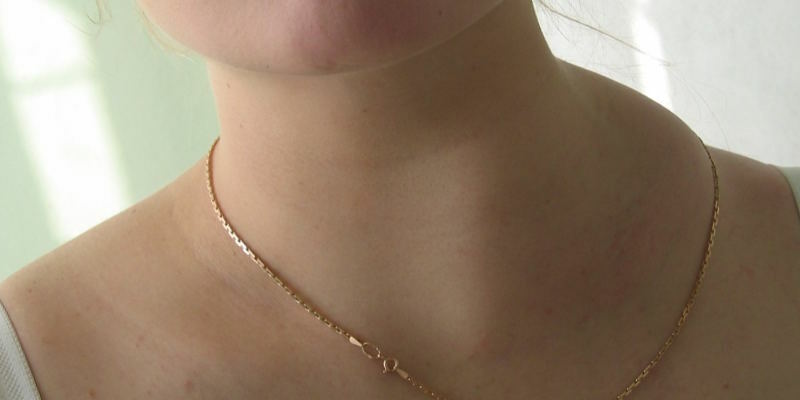
In acute lymphadenitis, inflamed nodes increase significantly in size, become painful, and the skin turns red. Simultaneously with this, other symptoms appear-high fever, chills, headaches, general worsening of the condition.
Chronic lymphadenitis occurs without severe symptoms. Lymphonoduses are enlarged slightly, painful sensations are weak, or none at all.
An infectious agent can enter the lymph node in three ways:
- is hematogenous( with blood);
- is lymphatic( with lymph);
- pin.
In a normal state, the lymph nodes are practically not palpable, only on the front surface of the neck can palpation detect small, soft and elastic nodules that are mobile and painless. With lymphadenitis, the nodes significantly increase in size, become inflamed and painful.
Causes of inflammation of the lymph nodes in the neck
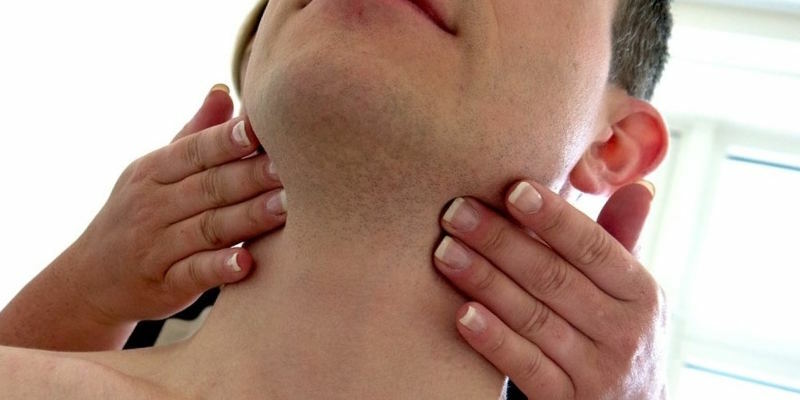
Specific and nonspecific infectious agents can trigger the development of lymphadenitis. Among the causative agents of the infection, the leading role belongs to pathogenic bacteria( staphylo- and strepococcus), which penetrate into the lymph node from the primary focus of infection. The causative agent of a specific cervical lymphadenitis is a tubercle bacillus, gonococci or pale treponema( with syphilis).
Cervical lymph nodes are responsible for all processes occurring in the soft tissues of the face, mouth, neck and hearing organs, therefore the most likely causes of their inflammation can become the following pathologies:
- infectious diseases - ARVI, ARI, influenza, measles, mononucleosis, chicken pox,diphtheria, AIDS, etc.;
- ENT - infections - sore throat, laryngitis, senusitis, tracheitis;
- diseases of the organs of hearing( otitis media, inflammation of the tympanic membrane);
- infections of the oral cavity - caries, periodontitis, gingivitis, stomatitis, glossitis( inflammation of the tongue);
- autoimmune pathologies( Sjogren's syndrome, sarcoidosis, lupus erythematosus);
- malfunctions in the immune system caused by overcooling with stress, hypovitaminosis, or untreated infections;
- oncological diseases - a tumor process in the lymph node or in other organs( more often in the brain);
- mechanical damage to the site itself or injury to surrounding tissues;
Much less often the cause of inflammation of the lymph nodes in the adult in the neck are metabolic disorders, thyroid disease, allergic reactions or intoxication of the organism in chronic alcoholism.
Symptoms of

After penetrating the lymphoid gland, the infectious agent begins to multiply actively, releasing toxins, which leads to the development of the inflammatory process and the appearance of characteristic symptoms.
The main signs of lymphadenitis:
- lymph node increases in size several times and can reach the value of walnut:
- , when the palpation of the node appears severe soreness;
- changes the structure of its tissues - from a soft and elastic knot turns into a dense and hard lump, and when pus accumulates a loose consistency;
- the skin over the inflamed lymph node becomes red and swollen;
- at the same time there is a deterioration in the overall standing - the temperature rises, the patient complains of chilliness, headache and other signs of intoxication of the body.
With cervical lymphadenitis, head turns are accompanied by severe pain, there are difficulties with swallowing food, appetite disappears, there is a strong weakness.
Symptoms of lymphadenitis in children
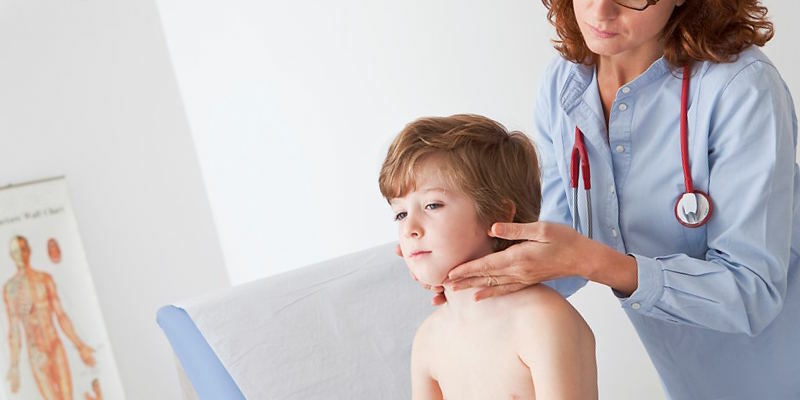
Acute inflammation of the lymph nodes in the neck in a child is most often associated with a bacterial or viral infection in the nasopharynx or oral cavity. As a rule, against a background of a sharp rise in temperature, parents notice an increase in the size and inflammation of the cervical lymph nodes. The child refuses to eat, sleeps badly, can hardly swallow food and even taking a liquid causes the child to have painful sensations.
These symptoms are associated with weakness, lethargy, lack of appetite, nausea. A characteristic sign of lymphadenitis is swelling and severe soreness of the inflamed lymph node, redness and swelling of the skin above it. Parents should show the child to the doctor as soon as possible in order to make the correct diagnosis and start treatment in time, which will help prevent unwanted purulent complications.
Chronic cervical lymphadenitis in a child can develop against the background of any inflammatory process in the neck and head. Since the baby's immune system is not yet fully formed, it can not fully cope with the infection, so the process takes a sluggish character.
In this case, the lymph nodes are almost painless, but enlarged, which is detected by palpation. But the state of health of the baby is quite satisfactory and there is no temperature increase. The task of the doctor and parents in this case is to strengthen the immunity of the baby and prevent colds and infectious diseases.
What is the risk of inflammation of the lymph nodes in the neck?
In the absence of timely treatment, the disease progresses, pus accumulates in the thickness of the lymphatic tissues, which eventually melts the tissue of the node. In this case, two options are possible: either an encapsulated abscess is formed, or adenophlegmon is formed, which can lead to the formation of lymphatic fistulas.
With purulent abscesses, pathogens with blood flow are carried throughout the body, which increases the risk of developing such a dangerous complication as sepsis.
Diagnostic methods
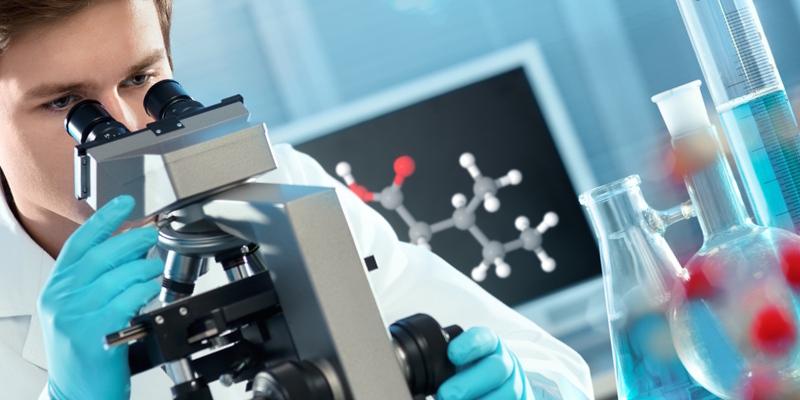
What if I have inflamed lymph nodes in the neck? In the first place, you need to seek advice from a therapist. The diagnosis of an acute nonspecific cervical lymphadenitis usually does not cause difficulties. After the examination and palpation of the affected area, the specialist, based on the clinical signs and complaints of the patient, can make a preliminary diagnosis. To establish the cause of the disease, a number of laboratory and instrumental studies are needed:
- a general and biochemical blood test;
- PCR blood test to identify the pathogen( virus or bacteria);
- ultrasound of the affected lymph node.
Other diagnostic methods may be used according to indications - ultrasound of lymphatic vessels, contrast lymphography, MRI or CT.In some cases, a puncture biopsy is needed - puncture of the lymph node with the fence of the affected cells for histological examination.
For the diagnosis of specific lymphadenitis use special research methods that allow you to isolate the pathogen from the lymph node( tubercle bacillus or pale treponemia).Additionally, if a suspected tuberculous lymphadenitis is made, the chest radiograph is taken.
Based on the results of the examination, the therapist will send the patient to continue treatment to a narrow specialist - otolaryngologist, infectious disease specialist, hematologist, dentist, surgeon or oncologist.
Treatment of
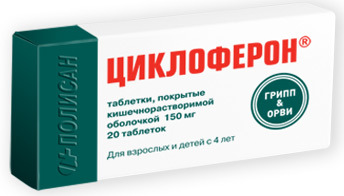 Photo: Cycloferon
Photo: Cycloferon Only a specialist decides how to treat lymphadenitis and individually selects a therapy regimen taking into account the underlying disease. The essence of treatment is reduced to active therapy of the underlying disease that causes inflammation, as well as correction and strengthening of immunity.
- If the inflammation of the lymph nodes is caused by a bacterial infection, antibiotics are prescribed. So, antibacterial therapy is used for ENT infections, dental problems, furunculosis, otitis, suppuration of the lymph node. If complications develop( phlegmon, purulent abscess), in addition to taking antibiotics resort to surgical treatment aimed at opening the purulent abscess. Preparations must be selected taking into account the type of pathogen, usually a broad spectrum antibiotics from the group of aminopenicillins or cephalosporins of the 3rd generation.
- For herpetic infection or infectious mononucleosis, antiviral agents and drugs from the group of interferons are prescribed for the treatment of the underlying disease( Viferon, Cycloferon);
- If the inflammation of the cervical lymph nodes is associated with dental problems, it is necessary to sanitize the foci of inflammation. Additionally, physiotherapeutic treatment is prescribed-UHF, galvanization.
- Lymphadenitis caused by fungal agents( for example, with candidiasis of the oral cavity) is treated with combined antifungal antibiotics - Diflucan, Clotrimazole.
For indications, use anti-inflammatory drugs( Diclofenac, Nimesulide), drugs with absorbency( Serta).Locally recommend the application of compresses with an anti-inflammatory solution of Dimexide. To maintain immunity, the administration of multivitamin complexes( Duovita, Multitabs, Vitrum) and plant immunomodulators( Immunala, tincture of echinacea, ginseng or eleutterococcus) is prescribed.
Dosage of
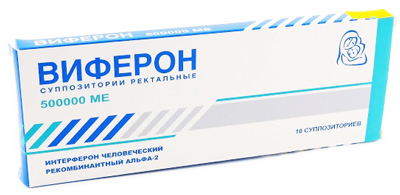
The doctor determines the dosage of preparations and the duration of the course of treatment individually. The patient must strictly follow all the recommendations of the attending physician in order to achieve a speedy recovery.
In cases where lymphadenitis develops before the purulent stage, one drug treatment is indispensable. The surgeon connects to the treatment process, which opens a purulent abscess or adenophlegmon, cleans the wound and performs antiseptic treatment. Later, during the healing process, the wound is drained and treated simultaneously with the administration of systemic antibiotics.
Therapy of specific lymphadenitis is carried out according to special protocols for the treatment of the underlying disease - tuberculosis or syphilis.
Of the physiotherapeutic methods of treatment, UHF sessions( ultrahigh-frequency therapy) are considered to be the most effective. The essence of this technique in the impact on the body of electromagnetic waves of ultrahigh frequency. The use of UHF helps to alleviate the unpleasant symptoms of the disease, reduce the soreness of the lymph nodes and accelerate recovery.
In the process of treatment, the patient is recommended to rest and bed rest, elimination of physical exertion, easy milk and vegetable diet, abundant warm drink. The best option will be vitaminized drinks that will help to remove toxins from the body and support immunity - green tea with raspberries and lemon, broth of dogrose, fruit drinks, compotes.
Any of these actions can aggravate the inflammatory process and promote the spread of infection throughout the body, which can lead to unfortunate consequences, for example, the development of sepsis.
Folk remedies for the treatment of lymphadenitis
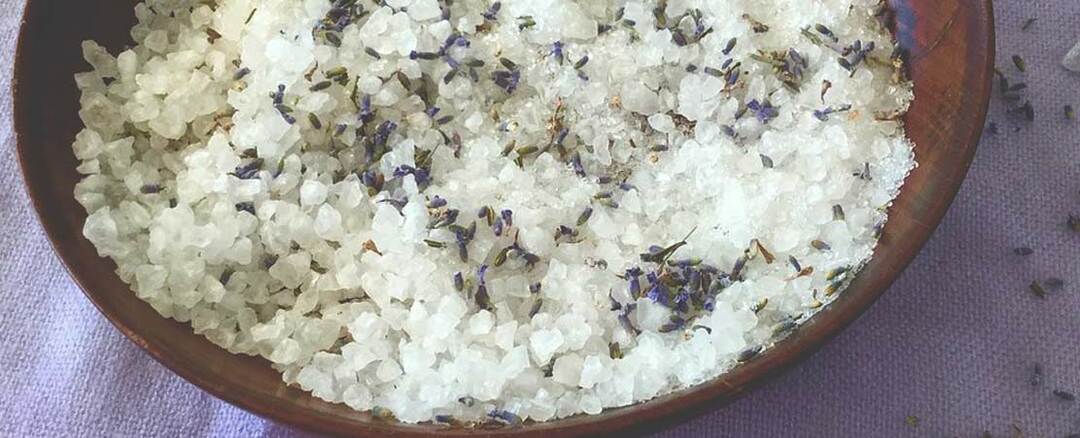
Before using folk remedies, be sure to consult a doctor and use only proven recipes. At home, for the treatment of inflamed lymph nodes recommend decoctions and infusions of herbs, as well as rinsing, if the focus of inflammation is in the nasopharynx.
Rinse with sea salt
The procedure is recommended to be done every 2-3 hours, it will help reduce pain and swelling, as sea salt has strong antiseptic and bactericidal properties.
It is enough to dissolve 1 tbsp.l.salt in 500 ml of hot boiled water, slightly cool this solution and in a warm form to use for rinsing. If the solution is for the baby, then the salt concentration should be reduced by half.
Rinse with herbal decoction
To prepare a decoction, you can take any plant with anti-inflammatory and antiseptic properties - chamomile, mint, sage, St. John's wort, calendula.1st.l.dry leaves you need to pour 200ml of boiling water and let it brew for 10 -15 minutes. With a warm broth, rinse your throat as often as possible( the first day of the disease - every hour).
Aloe vera
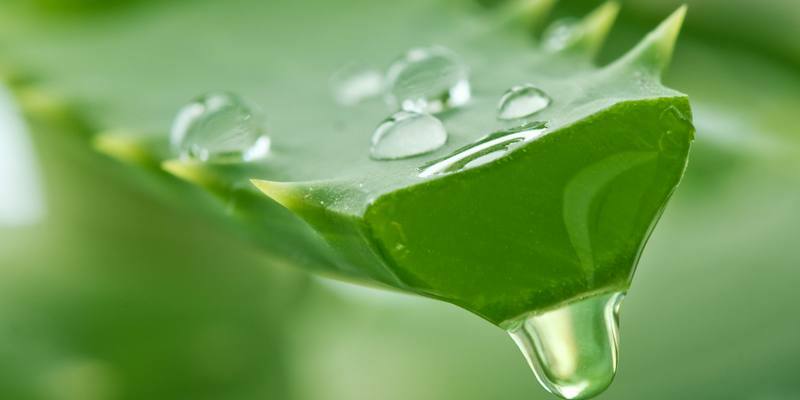
This amazing plant has many healing properties and has antiseptic, antimicrobial, anti-inflammatory and restorative effect. It is enough to rip a fresh leaf of a plant, to clear it from a rough skin and thorns, pulp to grind and squeeze out juice. Aloe juice( in the amount of 1 tbsp) is recommended to be taken on an empty stomach, every morning, before breakfast.
Tincture of Echinacea( ginseng, magnolia vinegar)
This is a powerful remedy for strengthening immunity and restoring its resistance to various infections. Just 10 drops of any of these agents, dissolved in 50 ml of water, will help to cope faster with the disease. Take vegetable immunomodulators need twice a day( in the morning and at lunch).
Green jadeite
This is a unique stone, famous for its medicinal properties. A beautiful translucent mineral of green color is used in folk medicine as a remedy to relieve pain and inflammation. Healers are advised to pick up a stone about the same size as the inflamed lymph node and apply it to the affected area several times a day for 10 minutes.
Prophylaxis and prognosis
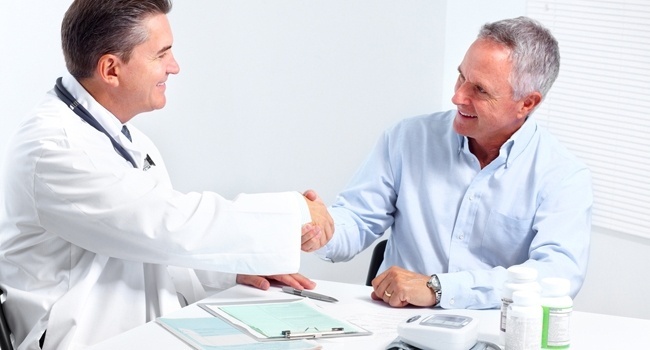 Doctor's consultation
Doctor's consultation Unfortunately, there is no specific prevention of lymphadenitis. But to prevent inflammation of the cervical lymph nodes is possible, if you lead a healthy and active lifestyle, exercise and support and strengthen immunity in every possible way. Timely treatment of infectious diseases( caries, otitis, tonsillitis) and foci of inflammation will help prevent penetration of pathogens into the lymphatic system and eliminate the conditions for the development of lymphadenitis.
With adequate and timely treatment of acute lymphadenitis, the prognosis is favorable, since after the elimination of the underlying disease the patient completely recovers. In chronic lymphadenitis, the prognosis is less than iridescent, since in most cases the functions of the lymph node are completely disturbed due to its complete replacement with connective tissue.
With purulent forms of lymphadenitis, everything will depend on the severity of the process. In advanced cases and in the absence of adequate treatment, the risk of severe consequences - septicopyemia and even sepsis is high, which is fatal.



